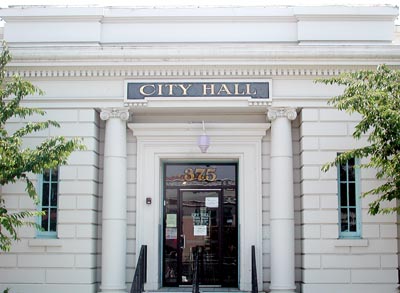City leaders put off the realignment from five districts to
four
– the at-large mayor would act as the fifth council member –
because a demographer contends that it’s
”
impossible
”
to redraw the boundaries while maintaining two districts
comprised of mostly Hispanic voters.
HOLLISTER
Citizens hoping to elect an at-large mayor will have to wait – likely until 2012 at the earliest – after Hollister council members Monday decided against a district realignment that some believe would have weakened the political voice of area Hispanics.
City leaders put off the realignment from five districts to four – the at-large mayor would act as the fifth council member – because a demographer contends that it’s “impossible” to redraw the boundaries while maintaining two districts comprised of mostly Hispanic voters.
Cities considering such changes are legally required to follow the most recent census data, from 2000. So by following the consultant’s guidance Monday, council members aren’t likely to consider a district realignment and coinciding at-large mayorship until after the 2010 census is done and the numbers are public.
With about a year lag time between the census and when the results are available, don’t expect Hollister voters to potentially decide on the matter until around 2011, more likely 2012.
“It was impossible to draw boundaries for four council districts that would comply with” federal voting guidelines, said Jeanne Gobalet, a partner with Lapkoff & Gobalet Demographic Research.
That came as “disappointing” news to Gordon Machado, a member of the local New Urbanism Committee lobbying for ballot consideration of electing an at-large mayor, and city officials had considered asking voters in November if they’d want to change the district structure to accommodate the new role.
Machado noted how he hadn’t “heard too many people” oppose having a mayor elected citywide, a move his group believes would add more weight to the position’s influence while giving the city a more refined voice. He said he understands the consultant’s take on the realignment in her “vein” as a demographer, but he had figured the map restructuring would be a “simple” task.
“I’m disappointed that logic and politics somehow don’t work hand in hand,” said Machado, who noted how his own mother was of Mexican heritage.
Although Hollister in 2000 was 55 percent Hispanic, just 39 percent of the registered voting population was made up by the county’s dominant ethnic background, Gobalet said. The 39 percent number is the one that’s relevant to federal voting laws that prohibit a city from “retrogressing” regarding the number of Hispanic districts in relation to the percentage of Hispanic voters.
Under the current alignment, two of five districts – or 40 percent – include mostly Hispanic voters. If council members would have approved one of the proposed realignments, just one district – or 25 percent – would have a majority of Latino voters.
“It’s pretty hard to argue that going from 40 percent to 25 percent isn’t retrogression,” said Quilter, adding that such a move potentially could be challenged in court.
But Machado contended that Hispanic voters would maintain their influence. Because while there would be three districts with mostly white voters and one mostly made up of Hispanic voters, the entire city would choose a mayor, he noted.
He also said he never has viewed race as a “factor” in local elections.
“It think Hollister has been color blind all these years,” said Machado, also a member of the planning and airport commissions. “So what’s the big deal?”
Mickie Luna with the local chapter of the League of United Latin American Citizens, which has opposed the realignment to four districts, could not be reached before press time.










